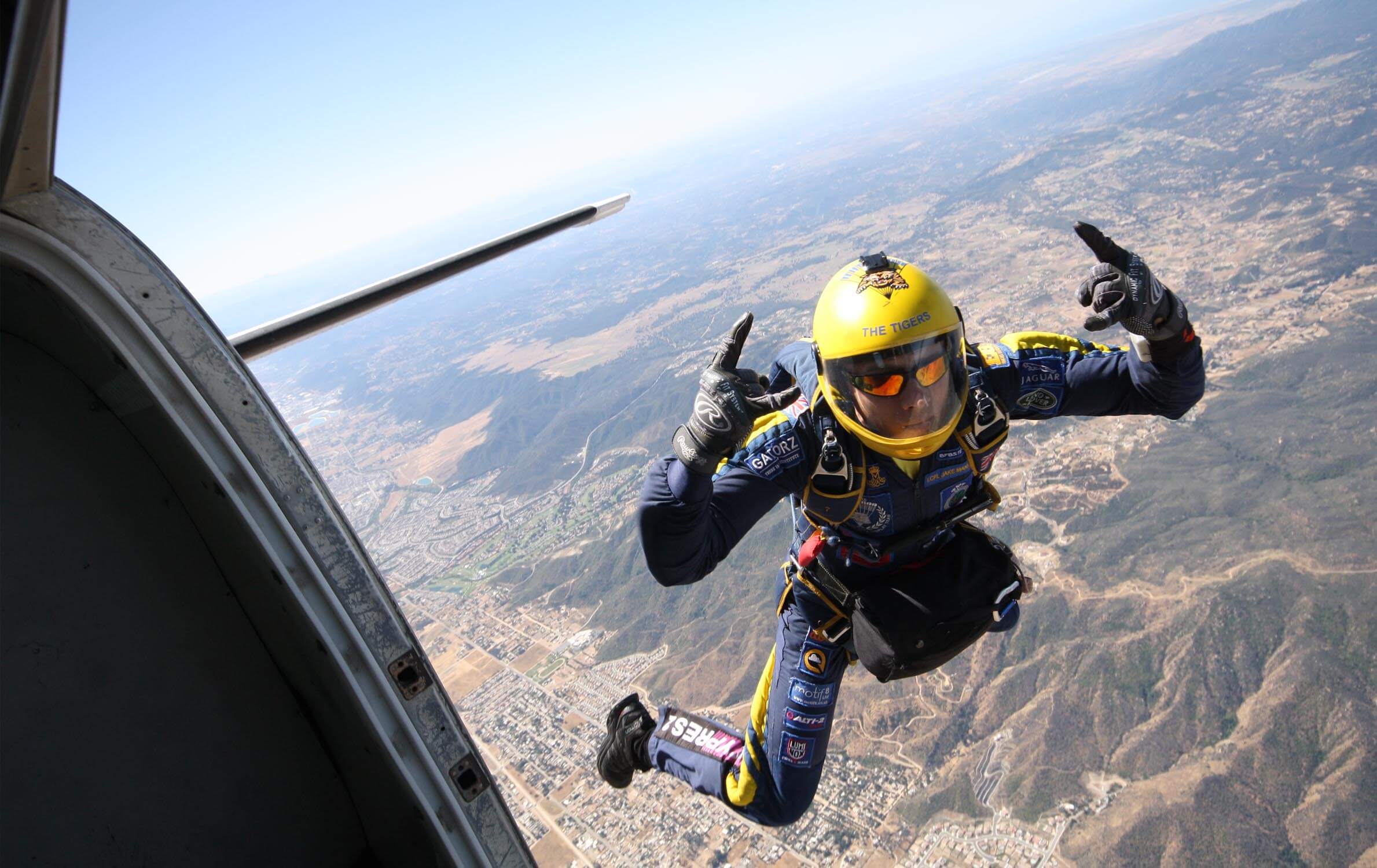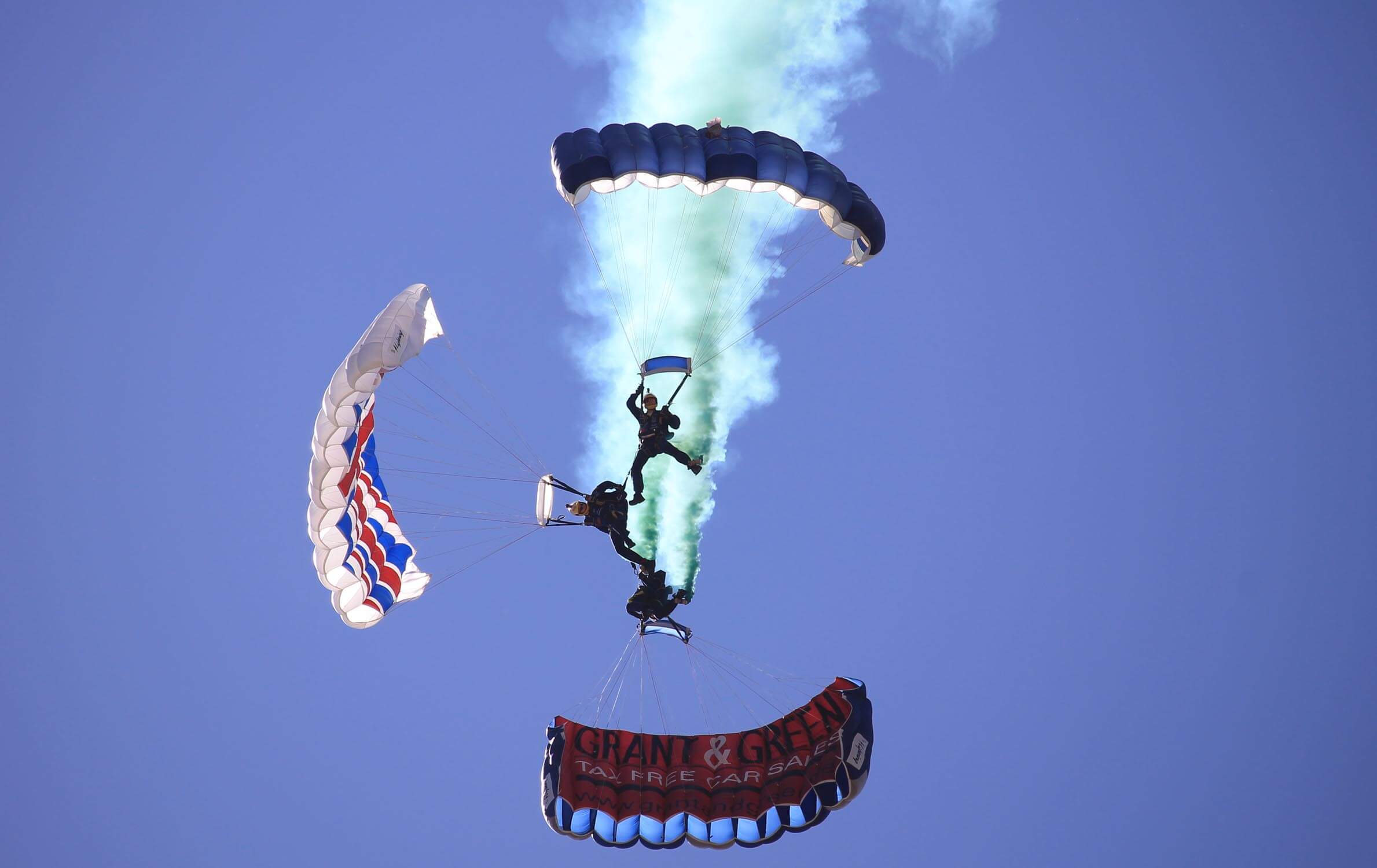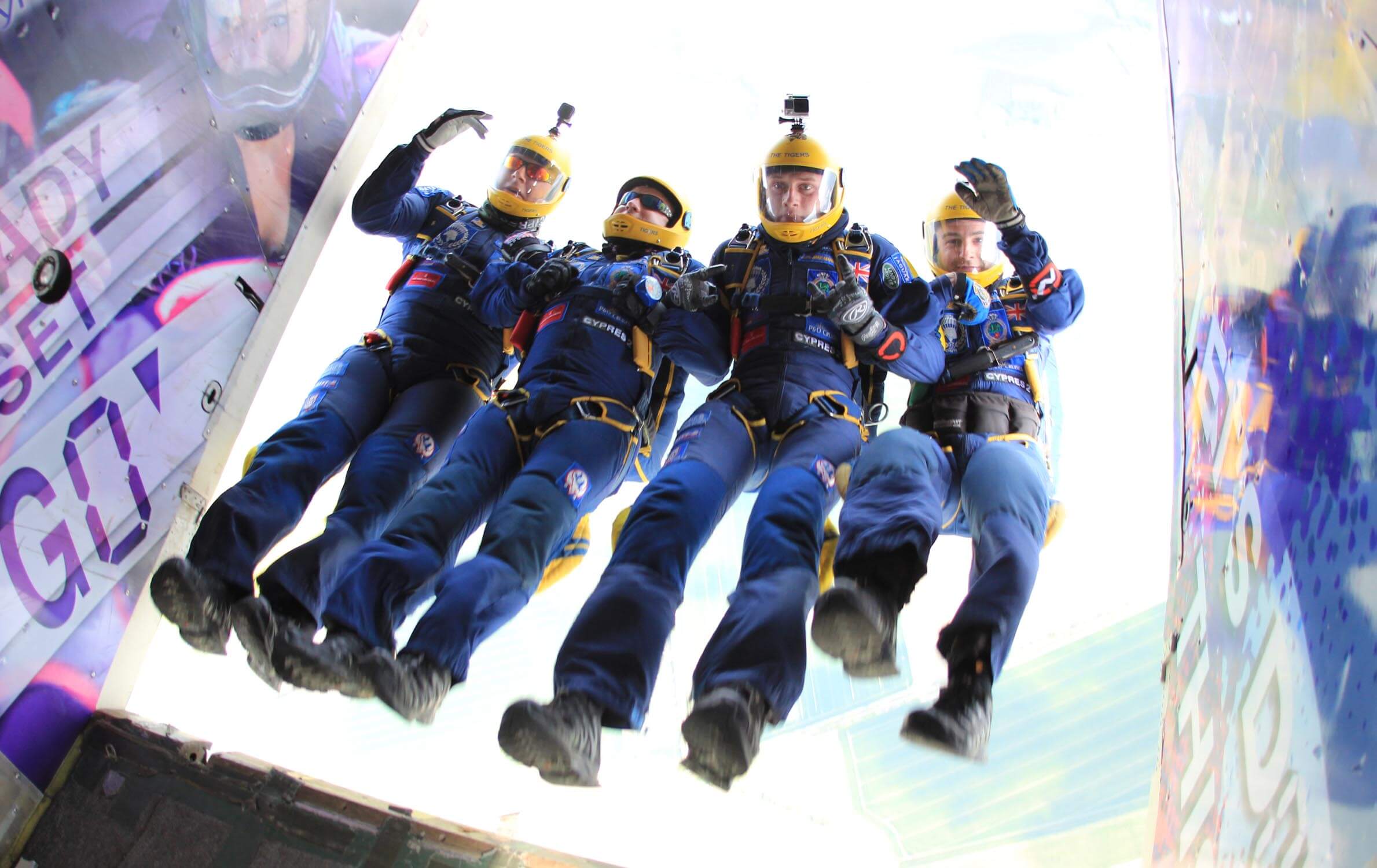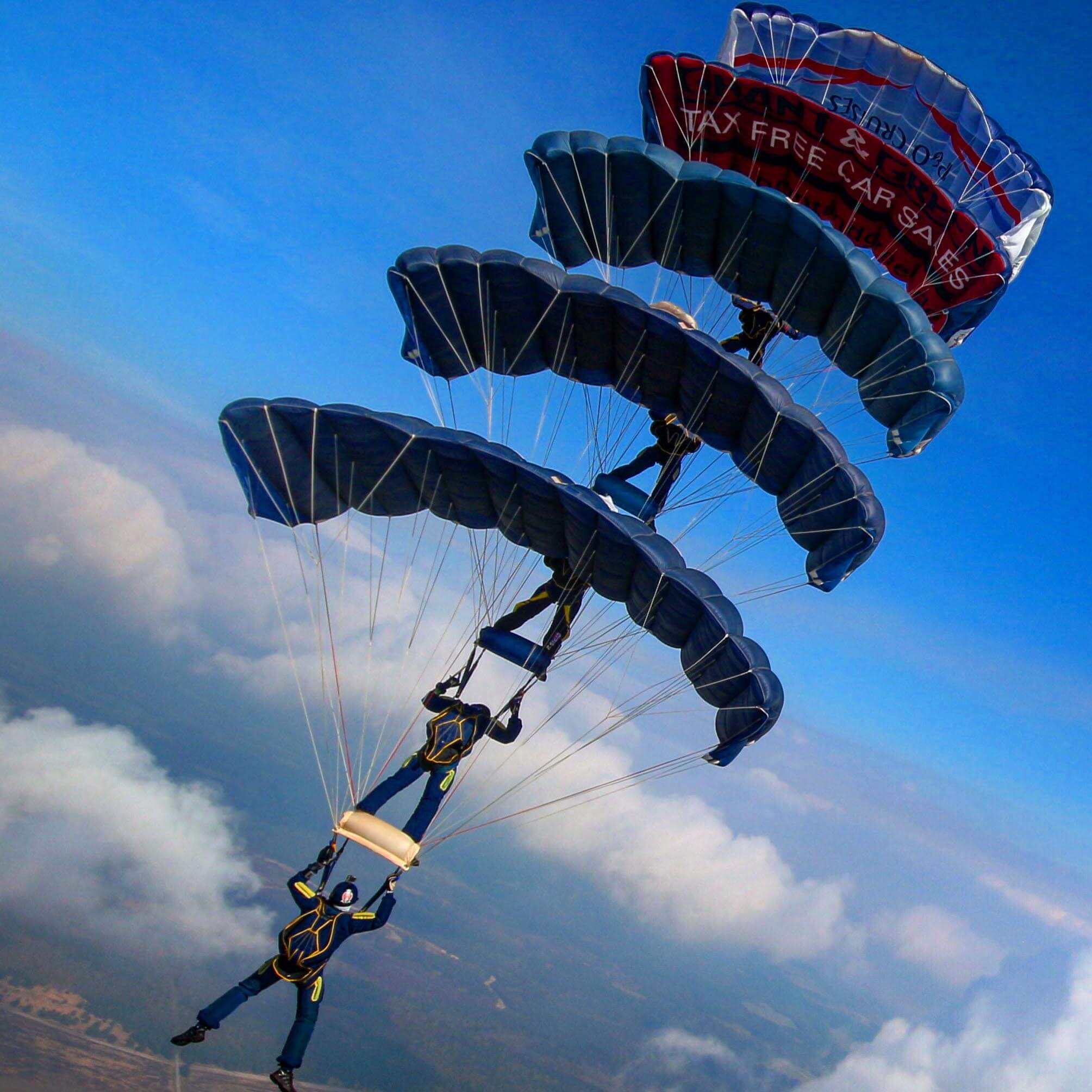Weather forecast CRW’y with a chance of torrential downplanes
By Jake Manwaring
Ever been on a flight line check where you’ve seen a few colourfully dressed Skydivers, with rigs that have so much canopy hanging out some would consider it already a Malfunction? You may also have seen the various military display team with hook & J knifes the size of something Rambo would use... or maybe it’s the ridiculous dirt dives you’ve seen; full of shouting and accessories that don’t look like they belong on any skydiver. Well there’s a reason for all of it and hopefully this article will help you understand and give you an insight to the crazy fun world of CRW.
Ok, so you may or may not have heard of CF or CRW, (Canopy Formations/Canopy Relative Work) It’s a discipline that takes place under canopy and involves two or more Canopy pilots, coming together and making physical contact between canopies; produce formations and fly them through the sky. (Some would argue that canopies don’t need to touch for CRW, as they can be flying relative to each other but I’d call that flocking).
History
So just taking a quick look back in history it is believed that CRW came about in and around the mid 70s when the first 2-way was formed by Bobby Gray and Mike Barber. After this was achieved the formation sizes have grown bigger and have taken new shapes. At first the technique of top docking where a canopy pilot would approach another canopy or formation from above was used to create CF Formations, but it soon became apparent that as the formations got bigger top docking became difficult. Top Docking is still used but is commonly now just between the first and second pilot creating the start of the formation. So, a group of jumpers called “Know-Sense Team” came up with the technique of rear docking/bottom docking. This technique then allowed for much bigger formations to take hold and so the first 8 Stack was made in the US in 1977 then in 1978 formations took to the skies with the first European 8-Stack being made with England flying a 13Way in the 1980s. Over time the CF formation sizes have grown with various countries holding their own records of achievements but as it stands the current world record is the 100-way Diamond that took place in Florida on the 21st of November 2007.
Categories
CF has 3 main categories and these fall into CF Competitions, Big Ways and Displays:
• CF Competitions happen at national and international level and have 3 Discipline categories to compete in, you have 2way Sequentials, 4way Sequentials and 4way Rotations with the 2way having 3 levels to compete at (Rookie, Intermediate, Senior). The Sequential category built up of either 4 or 2 jumpers plus one cameraman score points by producing different CF Formations within a certain time frame. The formations are chosen at random at the start of the competition and then the 2way has 30 sec to build the first formation from exit and then 1 minute of working time to complete their sequence and the 4way has the same 30sec but 2 minutes of working time. 4way Rotations is a slightly different comp with the aim
being to keep a stack built and have a continuation of one jumper rotating from the top of
the CF formation to the bottom. They have 30sec to build the 4stack and the 1min30sec to
get as many rotations in as they can. Within all of these competitions the camera-man has a
very important role to play as he will need to be close enough to record the jumps so that
the judges can see clearly that the docks have been made to score a point.
• Big Way CF Formations are one of the most air-spectacular things you can see both from the ground and within the sky or formation itself. This is because of the sheer size a formation can get, the wow factor from tricks like lights, pyrotechnics and streamers but also the risk
element that’s involved that definitely keeps the adrenaline pumping but very much keeps
everyone on the top of their game when trying to pull off such amazing feats. Currently as
mentioned the World Record stands at a 100way Diamond. The Largest formation to fly
over the UK dates back to the 80s with the Royal Marines forming a 24Stack. Most recently
a 13way was flown at Skydive Langer in 2019 and though many other big formations have flown over the UK we’ve yet to get enough experienced jumpers together to attempt to make a new record.
• Displays are the show stopping element that brings dynamic and technical formations to an audience with the use of probes(straps that connect pilots together), flags, smoke, pyrotechnics and streamers to enhance the viewers experience. It’s a part of CRW that requires a lot of training and a very good amount of canopy piloting skills as displays are mainly done for the public and can have you landing into an arena as small as 75*x75*m or 100*x50*m with little places to land outside of the designated Display arena. It could have crowds and tents around all four sides or it could be into a stadium with built up sides. Displays are a rarer form of CRW to get into but it's not impossible. Mainly it’s military parachute display teams do displays because a lot of displays
are conducted by Airshows where you have a lot of military assets/Aircraft etc and a big
public audience to whom they can show and promote the Army, Navy & RAF. However,
there are civilian teams and other sponsored athletes that conduct displays that participate
the exact same training required to do so (Check out more in Sec.13 BPA ops Manual).
Either way from personal experience doing both Military and Civilian displays I can tell you
that they provide an amazing experience that you can’t get jumping onto a regular LZ.
 Photo credit: Tigers Army Parachute Display Team
Photo credit: Tigers Army Parachute Display Team
What can CRW or CF do for me?
You can gather a great deal of knowledge and skills that you can apply to all different areas of skydiving even when you are not particularly on a CF jump. CF will give you knowledge of how your CF canopy flies and add to your techniques on how you can adjust the flight of your canopy according to the situation with the use of fronts, rears and toggles. You will learn about the spot and run in of the aircraft (jump location) to give you more understanding of why and where you and others exit the aircraft for what jump or discipline you are doing. Lastly without putting you in the direct way of danger CF will try to enhance your knowledge and mental skill to deal with an incident and to stay calm in the event of one such as a wrap. This however shouldn’t be off putting because just like the activity of skydiving there is risk involved and with CF the risk is entanglements, because you are flying in close proximity to other canopies, taking docks and making physical contact with other pilots. But with this being said the risks are reduced by being coached properly and well trained by a competent and qualified CF Coach using the right and safe techniques put in place to make the reward so so satisfying.
 Photo credit: Tigers Army Parachute Display Team
Photo credit: Tigers Army Parachute Display Team
CRW/CF Parachute KIT
CF Kits are probably the things that look a little different to other skydiving Kits on the flight line or in the packing shed, this may be because it looks untidy and has various elements of the parachute sticking out where normally these would be neatly tucked away, but there’s a reason for this. CF Mains are predominantly 7cells with larger nose openings and are packed into containers without a D-Bag, the lines get stowed into a tail pocket on the canopy and the risers and toggles are left over their riser covers, this allows for the canopy to have a quick and on heading opening, it’s also why the canopy may by slightly sticking out of the rig itself along with the risers and toggles. Most canopies also have a 3ring system on the top skin of the parachute that when fully inflated collapses the pilot chute so that it is out of the way when flying with other canopies, these rings also need to be clear of the canopy itself when packing so can be stowed outside of the container unless you have the use of a ring cone. CF jumps are also normally conducted at lower altitudes like 6000-8000 Feet and you deploy your canopy soon after exiting the aircraft rarely leaving any more than a 5sec delay so that you don’t reach terminal velocity, hence not needing to use a D-Bag (As a side note if you reach terminal velocity with a CF Canopy without a D-Bag you’ll be advised to deploy your reserve rather than your main due to the risk of injury or a malfunction on deployment). Other items included with the basic kit will consist of a large hook or CRW knife for cutting canopy or lines in the event of a wrap if needs be, Radios or comms kit are used so that you can communicate with each other under canopy but these can fail so that's why open faced helmets are used to hear one another by the primary method of voice, the use of chest mounted altimeters also come in very handy and are far more easy to take a glance at as often your hands are either holding onto something or flying your canopy/slot.
 Photo credit: Tigers Army Parachute Display Team
Photo credit: Tigers Army Parachute Display Team
Why, who & how to start
Why start or dabble in interest into CRW/CF... As you can see it has a lot of areas to explore and has a lot to offer a skydiver at all levels. You never stop learning and CRW will keep giving you the opportunity to hone in on your canopy awareness skills from ch1 and ch2, install confidence in canopy piloting, teach you observations in the sky and formation, explain and explore about how to deal with canopy entanglements, malfunctions and cutaways. If this has piqued your interest or taken your fancy then the question you might be asking yourself is “how do I start?” If so, it’s as follows: You must have a British Skydiving B licence with a minimum of 100 jumps and at least 5 jumps within the last two months before wanting to conduct your first CF jump. If you meet those requirements then the next step is to find yourself a CF Coach to receive your “Safety Briefing 1: Canopy formations basics” to go on your first CF Jump with your coach. After that your coach will be jumping and conducting various CF skills with you for you to demonstrate to achieve your CF1 & CF2 Grades for which you get to add 2 more stickers to that awesome FAI sticker book of yours.
I’m based down in South East UK, Skydive Headcorn being my local DZ - however there are plenty of other CRW friendly DZ that may be closer to you. Also look out for the British SkydivingCRW roadshows up and down the country.
Ladies and Gentlemen, I hope you now have a little more of an insight in to the fun and crazy vast world of CRW/CF and that I’ll be seeing you on or in a diamond or downplane at a DZ near you soon. Stay safe and have Fun.
 Photo credit: Tigers Army Parachute Display Team
Photo credit: Tigers Army Parachute Display Team
